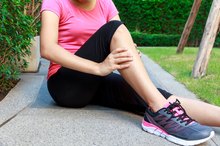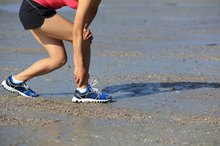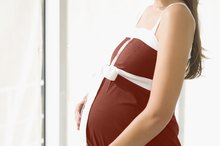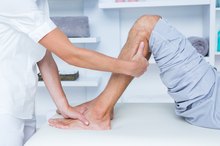A Blood Clot in a Leg or a Calf Muscle Cramp?
The calf is a common site for both muscle cramps and blood clots. Despite their propensity to affect the calf, blood clots and muscle cramps share little else in common. Calf cramps and blood clots differ with respect to symptoms, risk factors, causes, evolution, treatment and prognosis. Although calf cramps and blood clots both cause lower leg pain, the two conditions are usually easy to distinguish from one another.
If you are experiencing serious medical symptoms, seek emergency treatment immediately.
Pain and Other Symptoms
Calf muscle cramps characteristically come on abruptly, causing intense pain. When the cramps occur at night, they typically cause sudden awakening. Usually lasting a few seconds to a few minutes, the intense pain passes quickly once the muscle cramp releases. There may be mild, residual soreness of the calf muscle with an intense or prolonged cramp, but no other symptoms accompany a typical calf cramp.
In contrast to a muscle cramp, pain associated with a clot in a calf vein comes on gradually -- although some people have no symptoms. Pain from a calf blood clot is often described as achy, and is usually of mild to moderate intensity. A calf vein clot may be accompanied by swelling and redness of the affected lower leg, and possibly a low fever. The area over the clot may be tender. Unlike the pain from a calf cramp, pain due to a calf clot can persist for days or weeks.
- Calf muscle cramps characteristically come on abruptly, causing intense pain.
- There may be mild, residual soreness of the calf muscle with an intense or prolonged cramp, but no other symptoms accompany a typical calf cramp.
Causes and Risk Factors
Causes of Right Calf Swelling
Learn More
Calf cramps most often occur at night or while at rest, although they can occur during physical activity. The incidence of calf and other leg cramps increases with age.
The underlying causes of blood clot formation in a calf or another vein are: impaired blood flow, increased propensity of the blood to clot, damage to the blood vessel lining tissue -- or a combination of these factors. These abnormalities can trigger blood clot development within a blood vessel, impairing blood flow in the area. Blood clots can occur at any age, but the likelihood increases with age. Many factors can augment the risk for a blood clot by influencing one of the underlying causes, including: -- pregnancy, hormone replacement therapy or hormonal contraception -- stroke, spinal cord injury or another condition that limits mobility -- major surgery or a serious injury -- hip or knee replacement or fracture -- cancer or chemotherapy treatment -- prolonged bed rest -- long car, train or airplane ride with limited movement -- obesity -- smoking -- varicose veins
- Calf cramps most often occur at night or while at rest, although they can occur during physical activity.
- The underlying causes of blood clot formation in a calf or another vein are: impaired blood flow, increased propensity of the blood to clot, damage to the blood vessel lining tissue -- or a combination of these factors.
Health Effects
Although they are exquisitely painful, calf muscle cramps themselves pose no significant health threat. However, frequent or worsening calf cramps sometimes signal the presence of an underlying health problem, such as poor circulation or abnormal levels of electrolytes like sodium, potassium and calcium.
Blood clots in the superficial veins of the calf, known as superficial venous thrombosis, can cause phlebitis 4. This condition is characterized by pain and inflammation of the involved vein. Superficial vein clots typically do not pose a significant health threat. Clots in the deep veins of the calf -- known as deep venous thrombosis (DVT) -- are a more serious concern 5. These clots can fragment, allowing pieces to travel to and lodge in the lung arteries, a medical called pulmonary embolism (PE). PE is a potentially life-threatening condition and a medical emergency.
- Although they are exquisitely painful, calf muscle cramps themselves pose no significant health threat.
- However, frequent or worsening calf cramps sometimes signal the presence of an underlying health problem, such as poor circulation or abnormal levels of electrolytes like sodium, potassium and calcium.
Causes of Pain in the Leg After a C-Section
Learn More
Prevention and treatment for calf cramps have not been well studied. During an acute cramp, massaging the area and raising the toes toward the shin can help the calf muscle relax. Although proof of effectiveness is lacking, many doctors recommend preventive measures such as: -- increasing water intake -- staying hydrated during exercise -- replenishing salt lost after vigorous activity, especially potassium -- stretching the calves before and after exercise, and at bedtime
Management of superficial and deep vein clots in the calf differs, and the recommended therapy often varies depending on individual circumstances. Because of the risk of PE with deep venous thrombosis, it's important to seek medical attention right away if you suspect you might have a blood clot in your calf. Blood and ultrasound testing can quickly confirm or rule out the diagnosis. Seek emergency medical care if you experience any symptoms that might suggest a pulmonary embolism, including: -- chest pain -- shortness of breath -- feelings of anxiety or apprehension -- cough, which may produce blood -- dizziness or fainting -- unexplained sweating
Reviewed and revised by: Tina M. St. John, M.D.
- Prevention and treatment for calf cramps have not been well studied.
- Although proof of effectiveness is lacking, many doctors recommend preventive measures such as: -- increasing water intake -- staying hydrated during exercise -- replenishing salt lost after vigorous activity, especially potassium -- stretching the calves before and after exercise, and at bedtime Management of superficial and deep vein clots in the calf differs, and the recommended therapy often varies depending on individual circumstances.
Related Articles
References
- BMJ Clinical Evidence: Leg Cramps
- American Family Physician: Diagnosis of Deep Venous Thrombosis and Pulmonary Embolism
- Muscle Pain: Understanding Its Nature, Diagnosis, and Treatment; Siegfried Mense, et al.
- Merck Manual Professional Version: Superficial Venous Thrombosis
- Merck Manual Professional Version: Deep Venous Thrombosis (DVT)
- Family Practice Notebook: Pulmonary Embolism
- Rainbow CR, Fields KB. Calf injuries not involving the Achilles tendon. Fricker P, ed. UpToDate. Updated Feb 7, 2019.
- Chikazawa K, Netsu S, Akashi K, Suzuki Y, Konno R, Motomatsu S. Delayed diagnosis of single compartment muscle contusion after radical hysterectomy in the lithotomy position: A case report. Int J Surg Case Rep. 2016;26:199-201. doi:10.1016/j.ijscr.2016.07.057
- Fields KB, Rigby MD. Muscular Calf Injuries in Runners. Curr Sports Med Rep. 2016;15(5):320-4. doi:10.1249/JSR.0000000000000292
- Freedman BR, Gordon JA, Soslowsky LJ. The Achilles tendon: fundamental properties and mechanisms governing healing. Muscles Ligaments Tendons J. 2014;4(2):245-55.
- Alessandrino F, Balconi G. Complications of muscle injuries. J Ultrasound. 2013;16(4):215-22. doi:10.1007/s40477-013-0010-4
- Picerno V, Filippou G, Bertoldi I, et al. Prevalence of Baker's cyst in patients with knee pain: an ultrasonographic study. Reumatismo. 2014;65(6):264-70. doi:10.4081/reumatismo.2013.715
- Baima J, Krivickas L. Evaluation and treatment of peroneal neuropathy. Curr Rev Musculoskelet Med. 2008;1(2):147-53. doi:10.1007/s12178-008-9023-6
- Petsche TS, Selesnick FH. Popliteus tendinitis: tips for diagnosis and management. Phys Sportsmed. 2002;30(8):27-31.doi:10.3810/psm.2002.08.401
- Stager A, Clement D. Popliteal artery entrapment syndrome. Sports Med. 1999;28(1):61-70. doi:+10.2165/00007256-199928010-00006
- Mcdermott MM. Lower extremity manifestations of peripheral artery disease: the pathophysiologic and functional implications of leg ischemia. Circ Res. 2015;116(9):1540-50. doi:10.1161/CIRCRESAHA.114.303517
- Crum-cianflone NF. Bacterial, fungal, parasitic, and viral myositis. Clin Microbiol Rev. 2008;21(3):473-94. doi:10.1128/CMR.00001-08
- Somford MP, Hoornenborg D, Wiegerinck JI, Nieuwe weme RA. Are You Positive That the Simmonds-Thompson Test Is Negative? A Historical and Biographical Review. J Foot Ankle Surg. 2016;55(3):682-3. doi:10.1053/j.jfas.2016.01.021
- Pulivarthi S, Gurram MK. Effectiveness of d-dimer as a screening test for venous thromboembolism: an update. N Am J Med Sci. 2014;6(10):491-9. doi:10.4103/1947-2714.143278
- Bryan dixon J. Gastrocnemius vs. soleus strain: how to differentiate and deal with calf muscle injuries. Curr Rev Musculoskelet Med. 2009;2(2):74-7. doi:10.1007/s12178-009-9045-8
- Mackman N. Triggers, targets and treatments for thrombosis. Nature. 2008;451(7181):914-8. doi:10.1038/nature06797
- Muir RL. Peripheral arterial disease: Pathophysiology, risk factors, diagnosis, treatment, and prevention. J Vasc Nurs. 2009;27(2):26-30. doi:10.1016/j.jvn.2009.03.001
- American Academy of Orthopedic Surgeons. Muscle Contusion (Bruise). Updated 2014.
- American Physical Therapy Association. Physical Therapist's Guide to Calf Strain. Updated Oct. 17, 2019.
- Childress MA, Beutler A. Management of Chronic Tendon Injuries. Am Fam Physician. 2013 Apr 1;87(7):486-90.
- Grabowski G, Whiteside WK, Kanwisher M. Venous Thrombosis in Athletes. J Am Acad Orthop Surg. 2013 Feb;21(2):108-17.
- Rainbow CR, Fields KB. Calf injuries not involving the Achilles tendon. Fricker P, ed. Updated Feb 7, 2019.
Writer Bio
Cary is a registered nurse licensed in Illinois. She is a freelance health writer with more than 10 years nursing experience. Cary writes about health for EmpowHER.com and Blissfully Domestic.com, and contributed a chapter to Leave No Nurse Behind: Nursing Working with disAbilities by Donna Maheady.






